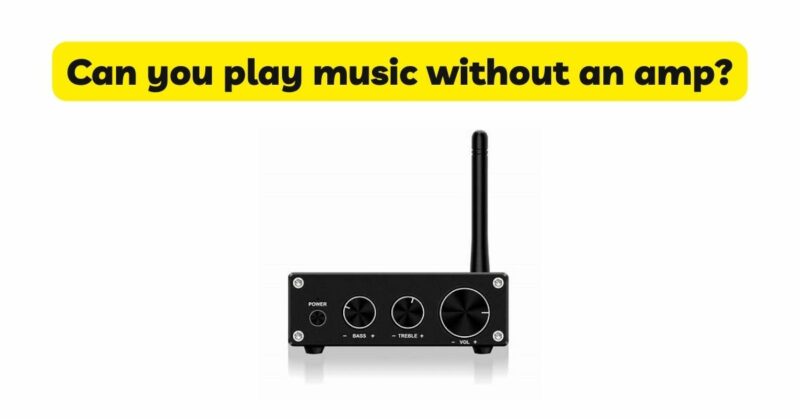Music is an integral part of our lives, and the way we listen to it has evolved over time. With the advancement of technology, portable music players, smartphones, and other audio devices have become common ways to enjoy our favorite tunes. However, you may wonder if it is possible to play music without an amplifier. In this article, we will delve into the concept of playing music without an amplifier, exploring the feasibility, limitations, and alternatives for music playback.
- Understanding Amplifiers:
Amplifiers, also known as amps, are electronic devices that increase the power and voltage of audio signals. They are commonly used to drive speakers or headphones, ensuring that the audio signal is amplified to a level that can be heard and enjoyed. Amplifiers come in various types, including integrated amplifiers, power amplifiers, and headphone amplifiers, each catering to specific audio output needs.
- Built-in Amplification:
Many audio devices, such as smartphones, laptops, and portable music players, come with built-in amplification systems. These built-in amplifiers serve the purpose of amplifying the audio signal to a suitable level for listening through headphones or the device’s built-in speakers. This means that for personal listening experiences, using these devices without an external amplifier is possible.
- Direct Speaker Connections:
When it comes to playing music through external speakers, the need for an amplifier becomes more apparent. Most speakers require a certain level of power to produce audible sound. Audio devices with built-in amplifiers are typically designed to drive headphones or small, low-power speakers. Connecting external speakers directly to these devices may result in insufficient volume, limited dynamic range, and compromised audio quality.
- Active vs. Passive Speakers:
It’s important to distinguish between active and passive speakers when discussing playing music without an amplifier. Active speakers, also known as powered speakers, have built-in amplifiers, allowing you to connect them directly to audio devices without the need for an external amplifier. These speakers are self-powered and designed to receive a line-level audio signal. In contrast, passive speakers do not have built-in amplifiers and require an external amplifier to provide the necessary power for sound reproduction.
- Limitations of Playing Without an Amplifier:
If you are using audio devices without built-in amplification and wish to play music through external passive speakers, there are limitations to consider. Connecting passive speakers directly to these devices may result in low volume levels, lack of clarity, and a reduced dynamic range. The audio signal may not be adequately amplified to drive the speakers, resulting in suboptimal listening experiences.
- Alternatives for Music Playback:
While playing music without an amplifier may have limitations, there are alternatives to consider for satisfactory music playback:
a. Powered Speakers: As mentioned earlier, powered speakers have built-in amplifiers, eliminating the need for an external amplifier. These speakers offer a convenient solution for those who want to enjoy music without the hassle of separate amplification.
b. Active Monitors: Active studio monitors, commonly used in music production and professional audio settings, are another alternative. These speakers have built-in amplifiers and provide accurate sound reproduction, making them suitable for critical listening and music enjoyment.
c. All-in-One Music Systems: All-in-one music systems, such as compact stereo systems or wireless speakers, often come with integrated amplifiers. These systems provide a complete audio solution, including amplification, speakers, and connectivity options, making them convenient for music playback in various settings.
d. Bluetooth and Wireless Speakers: Bluetooth and wireless speakers have gained popularity due to their portability and convenience. These speakers are often designed with built-in amplification, allowing you to connect wirelessly to your audio devices and enjoy music without the need for an external amplifier.
- Considerations for Audiophiles:
For avid audiophiles and those seeking the utmost audio quality, using a dedicated amplifier in conjunction with high-quality speakers remains the preferred option. Amplifiers designed for audiophile-grade sound reproduction offer enhanced power, precision, and control, elevating the listening experience to new heights. This setup allows for a more accurate representation of the music and preserves the nuances and subtleties that may be lost when using built-in amplification or compact systems.
Conclusion:
While it is possible to play music without an amplifier, the limitations in terms of audio quality and volume make it less ideal, especially when using external passive speakers. Audio devices with built-in amplifiers, such as smartphones and portable music players, are suitable for personal listening through headphones or built-in speakers. However, for a more immersive and satisfying audio experience, using powered speakers, active monitors, or dedicated audio systems with integrated amplifiers is recommended. These alternatives provide the necessary amplification and sound quality to truly appreciate the nuances of your favorite music. Ultimately, the choice depends on your preferences, listening environment, and the level of audio fidelity you seek.


